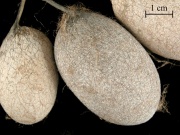Difference between revisions of "Wild silk"
(username removed) |
(username removed) |
||
| Line 2: | Line 2: | ||
== Description == | == Description == | ||
| − | Silk fibers produced by wild silk worms. The most common wild silk is called [http://cameo.mfa.org/materials/fullrecord.asp?name=Tussah | + | Silk fibers produced by wild silk worms. The most common wild silk is called [http://cameo.mfa.org/materials/fullrecord.asp?name=Tussah%20silk Tussah silk]. The filaments of Tussah are coarser than cultivated silk fibers. Wild silk is brownish and more difficult to bleach so it is usually dyed in dark colors. Other types of caterpillars also spin silky cocoons that are collected and used for cloth. Some of them are: |
-''Antheraea yama-mai'' (Japan), ''A. peryni'' (China, Europe): feeds on oak leaves | -''Antheraea yama-mai'' (Japan), ''A. peryni'' (China, Europe): feeds on oak leaves | ||
| Line 25: | Line 25: | ||
== Synonyms and Related Terms == | == Synonyms and Related Terms == | ||
| − | Tussah silk; seda salvaje (Esp.); ''Hyalophora cecropia; | + | Tussah silk; seda salvaje (Esp.); ''Hyalophora cecropia; Callosamia promethea; Attacus atlas; Attacus ricini; Antheraea assamensis; Antheraea mylitta; Antheraea yama-mai; Antheraea assama; Antheraea peryni; '' |
== Additional Information == | == Additional Information == | ||
| − | M.Brooks, S.O'Conner, J.McDonnell "The Application of Low-energy X-radiography in the Examination and Investigation of Degraded Historic Silk Textiles" ICOM Preprints, Edinburgh, Vol. II, p.670-79, 1996. | + | ° M.Brooks, S.O'Conner, J.McDonnell "The Application of Low-energy X-radiography in the Examination and Investigation of Degraded Historic Silk Textiles" ICOM Preprints, Edinburgh, Vol. II, p.670-79, 1996. |
== Additional Images == | == Additional Images == | ||
| Line 42: | Line 42: | ||
== Authority == | == Authority == | ||
| − | * | + | * R. J. Gettens, G.L. Stout, ''Painting Materials, A Short Encyclopaedia'', Dover Publications, New York, 1966 Comment: p. 231 |
| − | * | + | * G.S.Brady, ''Materials Handbook'', McGraw-Hill Book Co., New York, 1971 Comment: p. 722 |
| − | * | + | * Rosalie Rosso King, ''Textile Identification, Conservation, and Preservation'', Noyes Publications, Park Ridge, NJ, 1985 |
| − | * | + | * J.Gordon Cook, ''Handbook of Textile Fibres:I Natural Fibres'', Merrow Publishing Co. , Durham, England, 1984 Comment: p. 152 |
| − | * | + | * External source or communication Comment: Submitted information: Irene Good, Jan. 14, 2006. |
* Wikipedia, the free encyclopedia, at http://www.wikipedia.com Comment: http://en.wikipedia.org/wiki/Silk (Accessed Nov. 29, 2005) | * Wikipedia, the free encyclopedia, at http://www.wikipedia.com Comment: http://en.wikipedia.org/wiki/Silk (Accessed Nov. 29, 2005) | ||
Revision as of 07:38, 24 July 2013
Description
Silk fibers produced by wild silk worms. The most common wild silk is called Tussah silk. The filaments of Tussah are coarser than cultivated silk fibers. Wild silk is brownish and more difficult to bleach so it is usually dyed in dark colors. Other types of caterpillars also spin silky cocoons that are collected and used for cloth. Some of them are:
-Antheraea yama-mai (Japan), A. peryni (China, Europe): feeds on oak leaves
-Antheraea mylitta (India), A. assama (India): feeds on bher trees
-Antheraea assamensis (Muga silk moth, found in Brahmaputra Valley, Assam, Bengal and Indonesia): polyphagous
-Attacus ricini (Americas, Asia): feeds on castor oil plants
-Attacus atlas (Atlas silk moth):
-Callosamia promethea (Spicebush silk moth):
-Hyalophora cecropia (Robin silk moth)
Synonyms and Related Terms
Tussah silk; seda salvaje (Esp.); Hyalophora cecropia; Callosamia promethea; Attacus atlas; Attacus ricini; Antheraea assamensis; Antheraea mylitta; Antheraea yama-mai; Antheraea assama; Antheraea peryni;
Additional Information
° M.Brooks, S.O'Conner, J.McDonnell "The Application of Low-energy X-radiography in the Examination and Investigation of Degraded Historic Silk Textiles" ICOM Preprints, Edinburgh, Vol. II, p.670-79, 1996.
Additional Images
Authority
- R. J. Gettens, G.L. Stout, Painting Materials, A Short Encyclopaedia, Dover Publications, New York, 1966 Comment: p. 231
- G.S.Brady, Materials Handbook, McGraw-Hill Book Co., New York, 1971 Comment: p. 722
- Rosalie Rosso King, Textile Identification, Conservation, and Preservation, Noyes Publications, Park Ridge, NJ, 1985
- J.Gordon Cook, Handbook of Textile Fibres:I Natural Fibres, Merrow Publishing Co. , Durham, England, 1984 Comment: p. 152
- External source or communication Comment: Submitted information: Irene Good, Jan. 14, 2006.
- Wikipedia, the free encyclopedia, at http://www.wikipedia.com Comment: http://en.wikipedia.org/wiki/Silk (Accessed Nov. 29, 2005)




